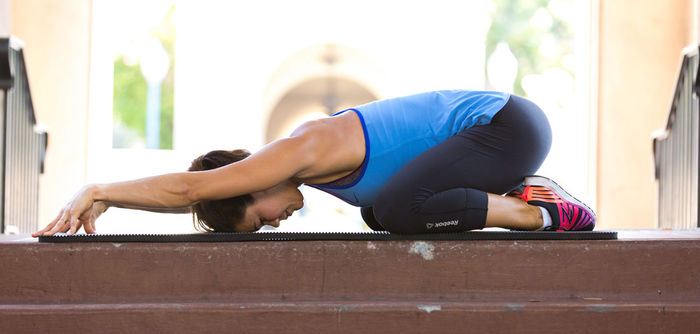As personal trainers and group fitness instructors responsible for what we do with our clients and classes, we often spend so much time preparing the content for the middle “bulk” of our sessions that we overlook two of the most important sections: the start and finish. Preparation for the safety and content of the bulk of client time proves important, but recent research suggests that our first and last five minutes hold the potential for the most impact (Cotman).
The first five minutes serve as an introduction to the session; we can call this the “Intro.” The last five minutes serve as the conclusion and valediction; we can call this the “outro.” Most Intros include a greeting, an expression of gratitude for showing up, a discussion of safety regarding equipment, and, for group fitness instructors, recognition of new faces. Because research suggests that more actual learning—including potential transference of behavior—may occur both at the start and finish of our sessions (Jensen), this blog post explores impactful non-traditional additions to what we are already doing as trainers and instructors.
Intros
Teaser #1
Many times we take for granted that because participants show up, they will stay—and be excited about staying—until the end. Nevertheless, a teaser gives them a reason to want to stay, giving them something to look forward to during the last third of your time together. For example, at a restaurant, if you ask to see the dessert menu when you first read the food menu, you’ll have an exciting dessert to look forward to from the start of your meal. In your classes and with clients, providing a metaphorical “dessert-like” anticipation with every Intro can make them excited and more motivated about the day’s program.
Group fitness example: a group fitness instructor could say, “Toward the end of class today we’re going to finish our strength sequence, changing our traditional classroom layout to fitness in-the-round,” or “The song of our last uphill climb today is a great new remix of my favorite new Beyoncé song.”
Personal trainer example: a personal trainer could say, “Today we’re going to use some aromatherapy during our final stretches to see how that can even deepen our stretch compared to last week,” or “We’re going to finish today learning the basics of a new piece of equipment called a foam roller as we roll out our muscles.”
Ice-Breaker
Give them a way to know you care about them. An ice-breaker is an activity that has nothing to do with traditional fitness; it involves them in a momentary distraction that really is an added value to the service you provide. Ice-breakers show the clients you care in making an effort to transcend fitness to other forms or brain and muscle games. They offer a way to connect on an emotional level beyond traditional “fitness,” and let your personality shine.
Group fitness example: a group fitness instructor could tell the students before starting class to group themselves in 30 seconds or less in huddles according to their Zodiac signs, or to line themselves up down the center of the room from tallest to shortest.
Personal trainer example: a personal trainer could say, “Tell me about what you ate for dinner last night, in reverse order,” or “Tell me what are 10 of your favorite foods and, for each one, if it is mostly plant based you do a jumping jack and if not you do a burpee” (so “gazpacho” would elicit a jumping jack response, and “pizza” gets a burpee).
Theme
Tell them what the focus is today. Whether you teach someone else’s lesson plans (such as pre-choreographed group fitness) or create your own, a theme is what you want clients to focus on for that particular class or session. Even if the music and moves from week to week are identical, a changing theme or focus gives students a responsibility to learn something about themselves with a unique focus. Changing the themes also brings variety to the sessions. During your session, restate the theme at least once every 10 minutes to emphasize your work with them.
Group fitness example: an instructor before class could say, “Today I invite you to focus on your posture in all of the positions we’ll be in today,” or “Our theme today is balance, so we are going to do the workout barefoot and see how that challenges us compared to the last class.”
Personal trainer example: a personal trainer could say, “Today our theme is balance, so we will introduce balance into all of our strength sets and reps in some way,” or “Our theme is eccentric training, so we will focus on slowing down and concentrating on the second section of all of our repetitions today.”
Intensity
Giving classes and clients some way to measure intensity helps keep them focused, and it reminds them of their responsibility to take ownership of how hard they need to work in that session. Possible measurements of intensity include the Talk Test, various Ratings of Perceived Exertion, and apps or wearable monitors such as the Apple Watch. Instead of waiting for the end of a session to ask classes and clients the usual “Did you get a great workout?” consider using the first five minutes to address intensity, such as saying, “During our session today, I'm going to show you most moves at a medium level 2 of intensity. I’ll also give you ways to increase intensity, called ‘progressions,’ and ways to decrease to a level 1, called ‘regressions.’ Try to choose what’s appropriate for you at all times, and an hour from now, I'm going to ask you if you chose the appropriate intensity for you today.”
Outros
In addition to thanking clients for coming, the following unique additions to your closure can help bring a bigger impact to your sessions, as well as underlining their responsibility in taking ownership for their time with you.
Teaser #2
As a teaser in the Intro creates excitement for why they have to stay, a teaser in the Outro gives them a real reason to be excited to return. Taking for granted they will show up does not help you stay on top of your game and think outside of the box of what is traditional.
Group fitness example: an instructor after a yoga class could say, “Next class we’re going to learn the moon salutation to add to our sun salutation,” or at the end of a cycle ride, “Please visit my Facebook wall to post your favorite motivating song for our next cycle class because we all together are going to build the class playlist online this week.”
Personal trainer example: a personal trainer could say, “In our next session we’re going to add a new tool called ‘gliding disks’ to our routine that really helps strengthen the adductors,” or “For our next session, we’re going to add a foam roller and learn what myofascial release is and how beneficial it is to your overall health and wellness of muscle fascia.”
Transcend a Skill
Teaching transcendence of a skill means to explain how at least one movement or thought pattern that day can improve the overall quality of their lives, and it serves as a homework assignment. Without teaching this, the session remains as a simple session spent together as movement. If we can truly influence them in the way we teach, then we show them how our time together enhances their activities of daily life, and the Outro is the time to remind them.
Group fitness example: an instructor could say, “Remember your form in the hip hinge today and try to keep it every time you bend over, using your legs and core instead of bending from the waist, like tonight when you brush your teeth before bed” or after yoga, “Remember before bed to try the alternate nostril breathing we learned today because it really helps balance the body and prepare you for sleep as well.”
Personal trainer example: a personal trainer could say, “Remember how we focused on the exhale during the concentric phase of every difficult move and see if you can remember to do that every time you get up from your desk at work because even that is one phase of a squat,” or “Remember how we learned to draw in and brace the core today, so try to keep that movement every time you bend over, twist, or pick something up.”
Restate the Theme
If you have done a great job at stating a theme or focus in the first five minutes, and reiterating it about once every 10 minutes, you should have no problem getting an answer at the end of the session when you ask, “What was our theme or focus today?” Being able to ask clients—and get the right answer immediately—shows you what a great job you have done at creating a theme for that session.
Intensity
Because your Intro includes telling them that you will ask them at the end if they worked hard enough today, the Outro is the time to remember to complete your promise. Asking “Did you choose for yourself the intensity that you needed today?” will always remind them they cannot give excuses such as “class was too hard,” or “you were too easy on me today,” because, while you offer a measurement of intensity, the appropriate choice of intensity depends on them.
Although initially you may think that the preceding concepts such as teasers and themes seem like a few cute things to do, you may find your clients appreciate these little treats of extra value and actually look forward to them. These things definitely help separate you apart from the competition as you maximize your power as educator in the first and last five minutes. To be sure, starting and ending sessions can be about the normal particulars based on movement, safety, and equipment. However, adding a few nontraditional aspects into some of the most impactful sections of our time with clients—the Intros and Outros—can help truly impact lives.
 by
by 







